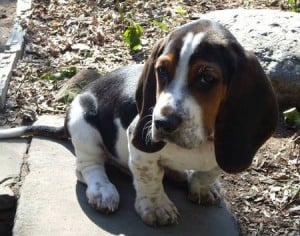From the desk of Sharda Baker.
Hi and Welcome Everyone!
This is Sharda with another Basset Hound newsletter!
How do we know that the dogs in front of us are Basset Hounds?
Like any other dog breed, they too have their own features that stand them out from the rest.
Let’s start!
Why is the Basset Hound a breed of distinction, you ask?
Well, certainly because of its low-lying body, gay tail and long, long ears.
Ordinarily, these dogs do not exceed one foot at the shoulder, but due to their heavy bones and muscles, can weigh between 18 kg and 36 kg. Though categorized as a medium-sized breed, he can really weigh over 32 kg—just like many large dogs! Females, though, are lighter, weighing between 18 kg-22 kg.
They are horizontally shaped dogs rather than tall, a conformation that can cause back problems if the dog is not managed properly.
The Basset Hound’s head is unique. While his skull is rounded and the muzzle deep, his skin is loose on the face and heavily wrinkled over the brow when his head is lowered to sniff the trail. Combine that with his pendulous ears and lips and face wrinkles and you’ve got yourself a winner!
His short legs end in massive paws. His fore feet turn slightly outward to balance the width of the shoulders while his hind feet point forward. If he has large feet, they help to make him steady, while his heavy bone structure makes him sturdy. His short legs too are advantageous in helping the hunter to follow him apace on foot without any difficulty.
If your Basset Dog is an excellent hunting dog, it points to the fact that he has a massive lung capacity and a large, strong heart to be able to track game for long periods of time. They are known to hunt for days together in different and difficult terrain, often with dense undergrowth. This is truly a hardy breed.
His coat is short, hard and dense fights water very effectively. He doesn’t need much formal grooming either, a matter of great relief to you whether you are a show dog owner or a house pet owner. The color and pattern of his coat are typical of hounds with tri-color (black, red and white), or red and white, or lemon and white. Blue, in fact a shade of gray, is also accepted by the standard but is not preferred since it is linked with genetic problems.
Your Basset Dog has a distinct sense of humor, is extraordinarily intelligent, affectionate and entertaining.
The physical characteristics of your Basset Hound: Your hound should ideally be slim and well muscled, healthy and free of disease. Only then can he perform to the best of his ability and capacity.
Front structure: The front structure of your pet should have deep and ample rib spring with its chest ably supported by his forelimbs. To have a good posture for hunting, his forelimbs must be able to support more than half of his body weight. So that his chest receives good support, his legs must drop from below his chest rather than beside it or outside it. Part of this support will necessitate his feet to turn out slightly. If your Basset Hound has a good powerful front structure without the strong driving rear, he will have plenty of initial speed, but will not be able to sustain it for long.
His chest: His chest may be very deep and shallow too, but it’s not too deep if:
• It is well supported by his legs
• It is balanced with the rear
His ribcage: The perfect Basset Hound has a round and tubular ribcage. This is helpful to him, as this will otherwise interfere with the free movement of his legs. His feet usually rest on thick pads that can take the shock of the heavy weight he bears on arduous runs. If he is true to his nature and is sensitive to scents, he will need to have a strong, long and well-muscled neck, but if he does have a short neck, put it down to his loaded or steep shoulders.
That’s it for now, hope you learned something.
I’ll be back for more about Basset Hounds.
Until then, all the best and take care.
Warmly,
Sharda Baker
